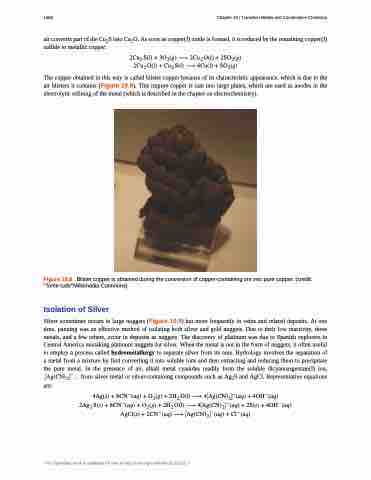Page 1072 - Chemistry--atom first
P. 1072
1062 Chapter 19 | Transition Metals and Coordination Chemistry
air converts part of the Cu2S into Cu2O. As soon as copper(I) oxide is formed, it is reduced by the remaining copper(I) sulfide to metallic copper:
���� ���� � ������ � ���� ���� � ������� ���� ���� � ��� ���� � ������ � ������
The copper obtained in this way is called blister copper because of its characteristic appearance, which is due to the air blisters it contains (Figure 19.8). This impure copper is cast into large plates, which are used as anodes in the electrolytic refining of the metal (which is described in the chapter on electrochemistry).
Figure 19.8 Blister copper is obtained during the conversion of copper-containing ore into pure copper. (credit: “Tortie tude”/Wikimedia Commons)
Isolation of Silver
Silver sometimes occurs in large nuggets (Figure 19.9) but more frequently in veins and related deposits. At one time, panning was an effective method of isolating both silver and gold nuggets. Due to their low reactivity, these metals, and a few others, occur in deposits as nuggets. The discovery of platinum was due to Spanish explorers in Central America mistaking platinum nuggets for silver. When the metal is not in the form of nuggets, it often useful to employ a process called hydrometallurgy to separate silver from its ores. Hydrology involves the separation of a metal from a mixture by first converting it into soluble ions and then extracting and reducing them to precipitate the pure metal. In the presence of air, alkali metal cyanides readily form the soluble dicyanoargentate(I) ion, ������������ � from silver metal or silver-containing compounds such as Ag2S and AgCl. Representative equations are:
������ � �������� � ����� � ��� ���� � ����������������� � �������� ���� ���� � �������� � ����� � ��� ���� � ����������������� � ����� � �������� ������� � �������� � ���������������� � �������
This OpenStax book is available for free at http://cnx.org/content/col12012/1.7


